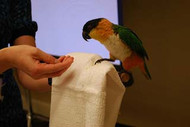How To Address Fear In Parrots
Posted by Fear in Parrots, scared Parrots on 26/1/2024
Here is how to address fear in Parrots.
Example
Have you ever been really scared? Perhaps it was a moment when you did not have control. For example as a passenger on a turbulent plane ride, or you realized someone was targeting you to pick your pocket, or you were stuck in a big crowd of people pushing you opposite to where you wanted to go.
The adrenalin rushes associated with those scary moments can be exhausting. Your body may shake, you may squirm, run or panic or even freeze.
Try hard to remember that feeling. It will make you a better Parrot trainer.

So many people think what they are doing to an animal is no big deal because they know it is not going to hurt the animal. Think of the Parrot that is being restrained against its will for a nail trim.
Many Parrots show significant signs of stress and fear when restrained by a towel. So much so they are terrified at the sight of a towel. I have also seen this happen with Parrots who have been strapped into a harness involuntarily.
Humans
While the humans may know no physical harm will come to the Parrot, the birds don’t know that. Their panic is real. Having empathy for that fear is important.
Getting past a fear response is not about forcing an animal through the experience until the event is over. An ideal strategy is to avoid creating the fear response in the first place. This may mean taking things a bit slower. And more importantly it usually meaning pairing things you know your Parrot likes with the experience.
I was recently at a friend’s house talking about desensitization and counter conditioning procedures and the different processes that can be used. We decided to explore some of the differences with a cute little terrier named Blue.
Blue
First we used systematic desensitization. Blue was resting peacefully on a chair. While she lay there we gradually moved a big scary vacuum closer and closer as long as Blue remained relaxed. We made sure she could see us moving the vacuum and watched her responses. Eventually the vacuum was right next to her and she showed no need to be anywhere else and continued resting peacefully.
In the next steps we moved the vacuum cleaner to the centre of the room and put treats all around it. Suddenly her body language changed. She sniffed, licked and explored every inch of the vacuum.
Conditioning
Later when we moved it to the side she wouldn’t leave it alone, even though all the treats were long gone. Her tail was wagging and her focus was on the vacuum. By pairing something Blue liked with the vacuum we went beyond tolerance to loving the machine.
I use these same procedures with Parrots all the time and I certainly don’t want my Parrots fearing things like scales, towels, nail trimmers, etc. First I start with systematic desensitization and then switch to classical conditioning, and then many times start incorporating operant conditioning.
I use shaping with approximations to teach my Parrots to actively present specific actions related to the no longer scary object, such as stepping onto the scale or taking fluids from the syringe. But first and foremost I avoid creating a fear response at all costs. Because I know fear is not always easy to overcome.

It’s true I am comforted when a pilot tells me turbulence is expected and for how long. However the truth is I am still much happier when there are no bumps at all. My flight is even better if there are movies to watch and snacks to enjoy.
Be empathic when your Parrot shows a fear response. Take a little time to help him overcome what he fears. The end result is worth it and helps you address fear in Parrots.
This article was originally published on Good Bird’s blog in May 2012
Get more advice on training your Parrot here.
Contact details
Barbara Heidenreich
www.BarbarasFFAT.com
www.GoodBirdInc.com
Barbara Heidenreich has been a professional animal trainer since 1990. Her company Barbara’s Force Free Animal Training (www.BarbarasFFAT.com) provides animal training DVDs, books, webinars and workshops. She has been a featured speaker in over twenty countries and has been published in nine languages. Barbara works with the companion animal community and also consults on animal training in zoos.

